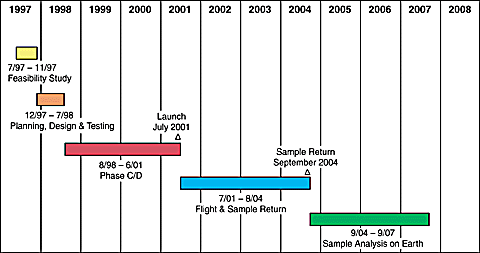|

Way

Things
To Do |
 Blast's
Cosmic Carnival Blast's
Cosmic Carnival
Blast
Goes To The Past
in
the
 ! !
|
Do you
know someone who came in first in a race? Perhaps it was you!
Wasn't it neat? NASA has some neat "firsts" too!
Look
at the list below. Can you see that they are in date order...meaning
that the list goes by the date that the first thing happened?
| NASA
"First" |
Date |
Mission
Name |
| First
U.S. satellite to orbit Earth |
January
31, 1958 |
Explorer
1 |
| First
American human in space |
May
5, 1961 |
Freedom
7 |
| First
American human orbital flight |
February
20, 1962 |
Friendship
7 |
| First
American space walk |
June
3, 1965 |
Gemini
4 |
| First
crewed lunar landing |
July
20, 1969 |
Apollo
11 |
| First
crewed Earth orbiter |
May
14, 1973 |
Skylab
|
| First
international space flight |
July
15, 1975 |
Apollo-Soyus
Test Project |
| First
space shuttle mission |
April
12, 1981 |
Space
Shuttle Columbia
(STS-1) |
| First
Earth orbiting observatory |
April
4, 1990 |
Hubble
space Telescope |
| First
sample return mission of the new millennium |
mid-2004
|
Genesis
|
What
was NASA's first "First"? What "Firsts"
can you think of for your family? (Hints: when you got or
lost your first tooth, your family's first car, who in your
family was born first, when your Mom or Dad got their first
job, when the first grandchild in your family was born, and
any more that you can think of.) Make a list of all these
"firsts" you can remember for you and/or your family.
You can also add important things, like when you or other
family members were born.
What
You Need
- Mission
Patches page print out
(if your patches are cut off in printing, you can also print
them from this pdf file.
If you don't have Adobe Acrobat on your computer, you can
download it here :)

- Your
own print out
- Masking
tape
- Construction
paper
- Tape
measure
- Markers,
colored pencils, or crayons (optional)
What
You Do
- Print
out the mission patches. Color and cut them out.
- Using
the masking tape, make a straight line on the wall or floor
that is 6 feet long.
- Measure
the line. Make 6 equal parts, marking each part with a piece
of tape. Start at the left side of the tape and move to
the right with your marks.
- Using
the construction paper, make a label for each decade beginning
with 1950 and concluding with 2010. Tape the decade labels
to the line in order beginning with 1950, on the farthest
left side, to the equal parts.
- Tape
each mission patch on the space where it belongs on the
timeline on one side of the line.
- Make
symbols for things in yours or your family's history and
tape them on the other side of the tape.
- You've
just made a timeline! How do your "firsts" compare
with NASA's?
Did
you Know?
The
Genesis mission sponsored its own patch contest, with entries
from all ages and all over the world. View the winning
patch entries.
NASA
keeps track of its own history by way of a timeline. See a
NASA
history fact sheet.The Genesis mission timeline marks
very important things as a "milestone," like when
the spacecraft was built. What additional milestones can you
see on the picture below?

Going
Further
Genesis
has other mission firsts! The
Genesis mission is the:
-First sample return of the new millennium.
-First to use bulk metallic glass as collector material.
-First mission to return from L-1.
-First to use a mid-air recovery for a sample return.
-First NASA mission to develop a class 10 cleanroom (only
10 particles of contaminant per cubic meter).
-First mission to study solar wind in exceptionally accurate
analytical mass spectrometer laboratories.
-First mission to partner with education research laboratory
(McREL) to provide education and public outreach for a mission.
See the Mission
section of the Genesis Web site to learn more about the mission's
timeline and its milestones.
Visit
the NASA History Web site at http://history.nasa.gov
to learn more about the history of NASA missions.
|
